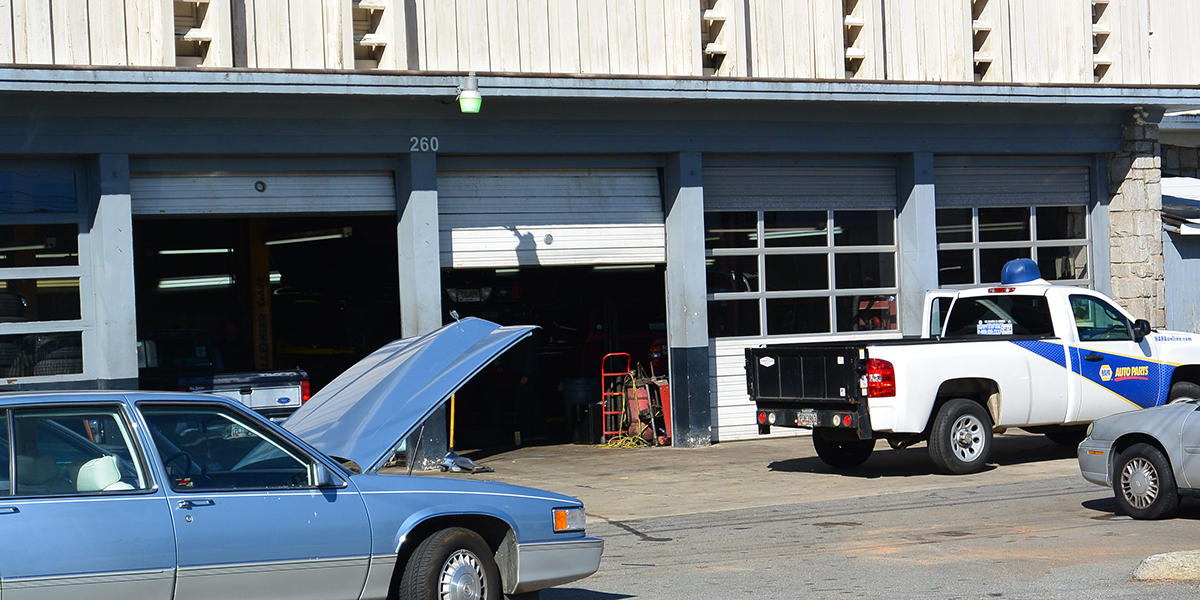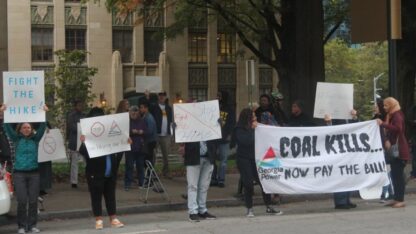Sandy Springs Auto Shop May Slow Down City Center Plans

Magic Mike’s Automotive in Sandy Springs is eligible to be on the National Register of Historic Places, according to Georgia’s Historic Preservation Division.
AL SUCH / WABE
The city of Sandy Springs said it’s putting on hold a plan to build two roundabouts and a park where an auto repair shop, Magic Mike’s Automotive on Mount Vernon Highway, is located.
On Tuesday night, Sandy Springs city council members unveiled new designs and approved $180 million in funding for its City Springs project: a 14-acre site across from the auto shop, which will include a new city hall, performing arts center, studio theater and public park.
The city has put the plans for greenspace where Magic Mike’s Automotive is currently located on hold, because the state’s Historic Preservation Division determined the auto shop was eligible to be listed under the National Register of Historic Places.
Historic Eligibility
The city of Sandy Springs said the 55-year-old building where Magic Mike’s Automotive now operates is not a historic site. But in a state review of the project, the shop on Mount Vernon Highway was flagged as potentially historic.
David Crass, director of the state’s historic preservation division, said the site is eligible for the National Register of Historic Places.
“It is a product of a very significant time in metro Atlanta’s evolution as a city, when widespread use of the automobile really revolutionized the way people lived and related to what used to be the downtown,” Crass said.
Possible Demolition
The shop recently changed its name from Eddie’s Automotive, but the building has been there since 1961.
The building’s eligibility to be a nationally registered historic building doesn’t prevent the city from tearing it down.
“There is this misconception that being listed on the National Register protects a resource,” Crass said. “It does not. It is just a stamp of approval that says, ‘Yes, the state office and National Park Service affirm that this resource is important and worthy of preservation.’ You could buy a house that’s listed on the National Register today and there would be nothing that would prevent you from doing that.”
Last year, a mansion in Sandy Springs that was on the National Register of Historic Places, was demolished.
State Review Process
Section 106 of the National Historic Preservation Act requires federal agencies and offices to review historic resources with the state when determining the impact of their actions. Crass said this came about after the U.S. Conference of Mayors lobbied Congress for protections against destruction of local resources.
“Federal agencies were coming into local communities and carrying out these big federal projects with no regard for historic resources, be they archeological sites or historic buildings and landscapes,” Crass. “So you can think of all the central downtowns that had all those awful HUD low-income housing towers or the interstate highway system.”
Because the Georgia Department of Transportation is spending federal funds to build the roundabouts near Magic Mike’s Automotive, a review of historic resources was required.
A consultant for the project did not find any historic resources, but the state’s historic preservation division disagreed.
“People are used to thinking about historic resources as being plantation house, slave cabins or archeological sites,” Crass said. “It’s really only in the last 10 to 12 years that state historic preservation offices have started looking closely as what we loosely refer to as mid-century modern historic resources. Eddie’s Automotive definitely falls into that timeframe because so much of our landscape in the 1950s and 60s was shaped by the wide availability of cars, which of course is really what drove the development of Sandy Springs and at the other, at that time, close-in suburbs.”
Next Steps
Magic Mike’s Automotive’s eligibility designation by the state means the U.S. Department of Transportation can appeal the designation with the National Park Service or explain why there’s no feasible alternative to its plan.
“All it simply does is establish a process by which [the Department of Transportation] has to consider the effects of the project on that building and then figure out if there’s a way for them to avoid or minimize those effects,” Crass said.
At the very least, Crass said, federal agencies are asked to take photographs for the historic record.
9(MDAxODM0MDY4MDEyMTY4NDA3MzI3YjkzMw004))








